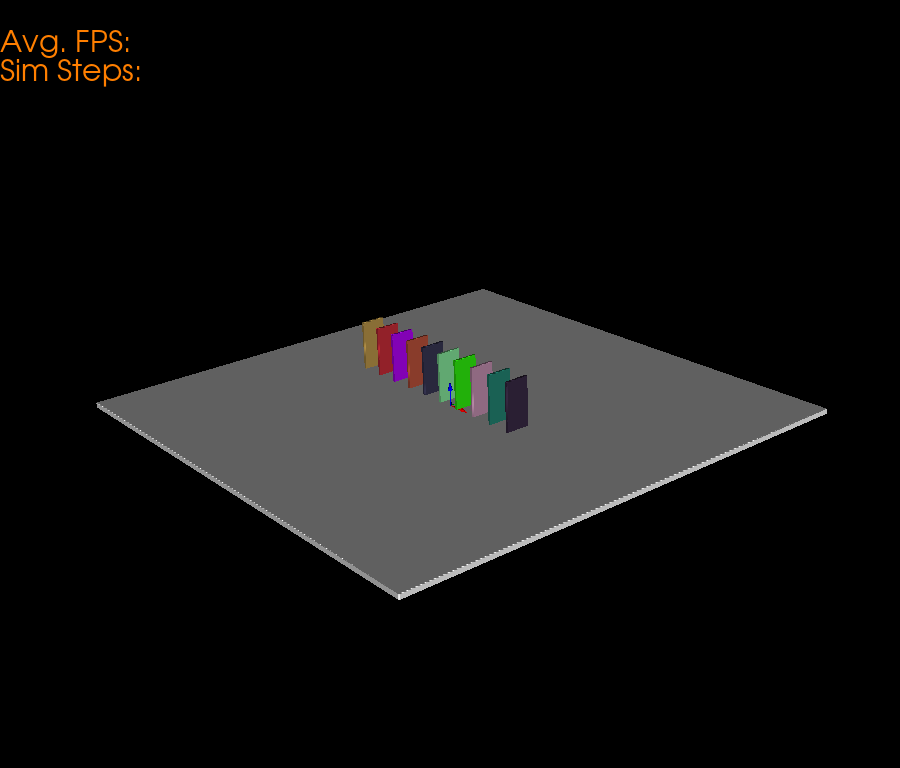Note
Go to the end to download the full example code
Domino Physics Simulation#
This example simulation shows how to use pybullet to render physics simulations in fury. In this example we specifically render a series of Dominoes which are under Domino Effect.
First some imports.
Set the Number of Dominoes for Simulation.
number_of_dominoes = 10
# Base Plane Parameters
base_size = np.array([number_of_dominoes * 2, number_of_dominoes * 2, 0.2])
base_color = np.array([1, 1, 1])
base_position = np.array([0, 0, -0.1])
base_orientation = np.array([0, 0, 0, 1])
# Render a BASE plane to support the Dominoes.
base_actor = fury.actor.box(
centers=np.array([[0, 0, 0]]),
directions=[0, 0, 0],
scales=base_size,
colors=base_color,
)
# half of the actual size.
base_coll = p.createCollisionShape(p.GEOM_BOX, halfExtents=base_size / 2)
base = p.createMultiBody(
baseCollisionShapeIndex=base_coll,
basePosition=base_position,
baseOrientation=base_orientation,
)
p.changeDynamics(base, -1, lateralFriction=1, restitution=0.5)
We define some global parameters of the Dominoes so that its easier for us to tweak the simulation.
domino_mass = 0.5
domino_size = np.array([0.1, 1, 2])
domino_centers = np.zeros((number_of_dominoes, 3))
# Keeping all the dominos Parallel
domino_directions = np.zeros((number_of_dominoes, 3))
domino_directions[:] = np.array([1.57, 0, 0])
domino_orns = np.zeros((number_of_dominoes, 4))
domino_sizes = np.zeros((number_of_dominoes, 3))
domino_sizes[:] = domino_size
domino_colors = np.random.rand(number_of_dominoes, 3)
domino_coll = p.createCollisionShape(p.GEOM_BOX, halfExtents=domino_size / 2)
# We use this array to store the reference of domino objects in pybullet world.
dominos = np.zeros(number_of_dominoes, dtype=np.int8)
centers_list = np.zeros((number_of_dominoes, 3))
# Adding the dominoes
for i in range(number_of_dominoes):
center_pos = np.array([(i * 0.99) - 5.5, 0.4, 1])
domino_centers[i] = center_pos
domino_orns[i] = np.array([0, 0, 0, 1])
dominos[i] = p.createMultiBody(
baseMass=domino_mass,
baseCollisionShapeIndex=domino_coll,
basePosition=center_pos,
baseOrientation=domino_orns[i],
)
p.changeDynamics(dominos[i], -1, lateralFriction=0.2, restitution=0.1)
domino_actor = fury.actor.box(
centers=domino_centers,
directions=domino_directions,
scales=domino_sizes,
colors=domino_colors,
)
Now, we define a scene and add actors to it.
scene = fury.window.Scene()
scene.add(fury.actor.axes())
scene.add(base_actor)
scene.add(domino_actor)
# Create show manager.
showm = fury.window.ShowManager(
scene, size=(900, 768), reset_camera=False, order_transparent=True
)
# Counter iterator for tracking simulation steps.
counter = itertools.count()
# Variable for tracking applied force.
apply_force = True
/opt/homebrew/Caskroom/miniforge/base/envs/py311-fury/lib/python3.11/site-packages/sphinx_gallery/gen_rst.py:722: UserWarning: We'll no longer accept the way you call the __init__ function in future versions of FURY.
Here's how to call the Function __init__: __init__(self_value, scene='value', title='value', size='value', png_magnify='value', reset_camera='value', order_transparent='value', interactor_style='value', stereo='value', multi_samples='value', max_peels='value', occlusion_ratio='value')
exec(self.code, self.fake_main.__dict__)
Now, we define methods to sync objects between fury and Pybullet.
# Get the position of base and set it.
base_pos, _ = p.getBasePositionAndOrientation(base)
base_actor.SetPosition(*base_pos)
# Calculate the vertices of the dominos.
vertices = fury.utils.vertices_from_actor(domino_actor)
num_vertices = vertices.shape[0]
num_objects = domino_centers.shape[0]
sec = int(num_vertices / num_objects)
Syncing Dominoes#
Here, we perform three major steps to sync Dominoes accurately. * Get the position and orientation of the Dominoes from pybullet. * Calculate the Rotation Matrix.
Get the difference in orientations (Quaternion).
Generate the corresponding rotation matrix according to that difference.
Reshape it in a 3x3 matrix.
Perform calculations to get the required position and orientation.
Update the position and orientation.
def sync_domino(object_index, multibody):
pos, orn = p.getBasePositionAndOrientation(multibody)
rot_mat = np.reshape(
p.getMatrixFromQuaternion(
p.getDifferenceQuaternion(orn, domino_orns[object_index])
),
(3, 3),
)
vertices[object_index * sec : object_index * sec + sec] = (
vertices[object_index * sec : object_index * sec + sec]
- domino_centers[object_index]
) @ rot_mat + pos
domino_centers[object_index] = pos
domino_orns[object_index] = orn
Here, we define a textblock to display the Avg. FPS and simulation steps.
Set the camera for better visualization.
scene.set_camera(
position=(10.46, -8.13, 6.18),
focal_point=(0.0, 0.0, 0.79),
view_up=(-0.27, 0.26, 0.90),
)
Timer callback is created which is responsible for calling the sync and simulation methods.
# Create timer callback which will execute at each step of simulation.
def timer_callback(_obj, _event):
global apply_force, fpss
cnt = next(counter)
showm.render()
if cnt % 1 == 0:
fps = showm.frame_rate
fpss = np.append(fpss, fps)
tb.message = (
"Avg. FPS: " + str(np.round(np.mean(fpss), 0)) + "\nSim Steps: " + str(cnt)
)
# Get the position and orientation of the first domino.
domino1_pos, domino1_orn = p.getBasePositionAndOrientation(dominos[0])
# Apply force on the First Domino (domino) above the Center of Mass.
if apply_force:
# Apply the force.
p.applyExternalForce(
dominos[0],
-1,
forceObj=[100, 0, 0],
posObj=domino1_pos + np.array([0, 0, 1.7]),
flags=p.WORLD_FRAME,
)
apply_force = False
# Updating the position and orientation of individual dominos.
for idx, domino in enumerate(dominos):
sync_domino(idx, domino)
fury.utils.update_actor(domino_actor)
# Simulate a step.
p.stepSimulation()
# Exit after 300 steps of simulation.
if cnt == 300:
showm.exit()
# Add the timer callback to showmanager.
# Increasing the duration value will slow down the simulation.
showm.add_timer_callback(True, 1, timer_callback)
interactive = False
# start simulation
if interactive:
showm.start()
fury.window.record(scene, out_path="viz_domino.png", size=(900, 768))

/opt/homebrew/Caskroom/miniforge/base/envs/py311-fury/lib/python3.11/site-packages/sphinx_gallery/gen_rst.py:722: UserWarning: We'll no longer accept the way you call the record function in future versions of FURY.
Here's how to call the Function record: record(scene='value', cam_pos='value', cam_focal='value', cam_view='value', out_path='value', path_numbering='value', n_frames='value', az_ang='value', magnification='value', size='value', reset_camera='value', screen_clip='value', stereo='value', verbose='value')
exec(self.code, self.fake_main.__dict__)
Total running time of the script: (0 minutes 0.111 seconds)
